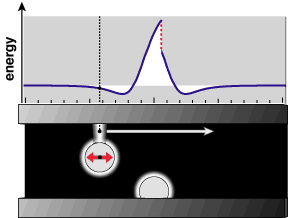Snapback

An energy dissipation mechanism.
When a part of nanoscale surface passivation A that sticks out
- gets pulled to the side and tensioned like a spring by an opposing part B,
- then slides past this opposing part B
- then swings back and forth unconstrainedly
- then looses its energy to vibrations of atoms that it is bonded to below.
Contents
Snapback either designed for or designed against
One will usually want to design reusable molecular machine elements such that they
either maximize snapback or avoid snapback all together by large margin.
Orthogonal set of mechanical components.
When designing for superlubrication snapback is highly undesired.
Energetically
This can be seen as a fusion of potential energy well
where the bottoms are not brought on the same height first.
The following dissipation is not visible in this model.
Bigger nanoscale snapback
Crystolecule clips that do not provide means for energy recuperation snap back. Larger size scales gives less energy loss from snapbacks.
Macroscopic analogy
Making a ruler vibrate on the corner of a desk.
Just that here energy mostly initially get dissipated into sound energy.
Related
- Nanoscale surface passivation
- Snapback exactly what one does not want when designing for superlubricity
- Snap connectors
External links
- Archived page from Eric Drexlers fomer website:
Softly supported sliding atoms can undergo abrupt transitions in energy - Complementary to that:
Stiffly supported sliding atoms have a smooth interaction potential
References
- ↑ Eric Drexlers former homepage (webarchive): Softly supported sliding atoms can undergo abrupt transitions in energy